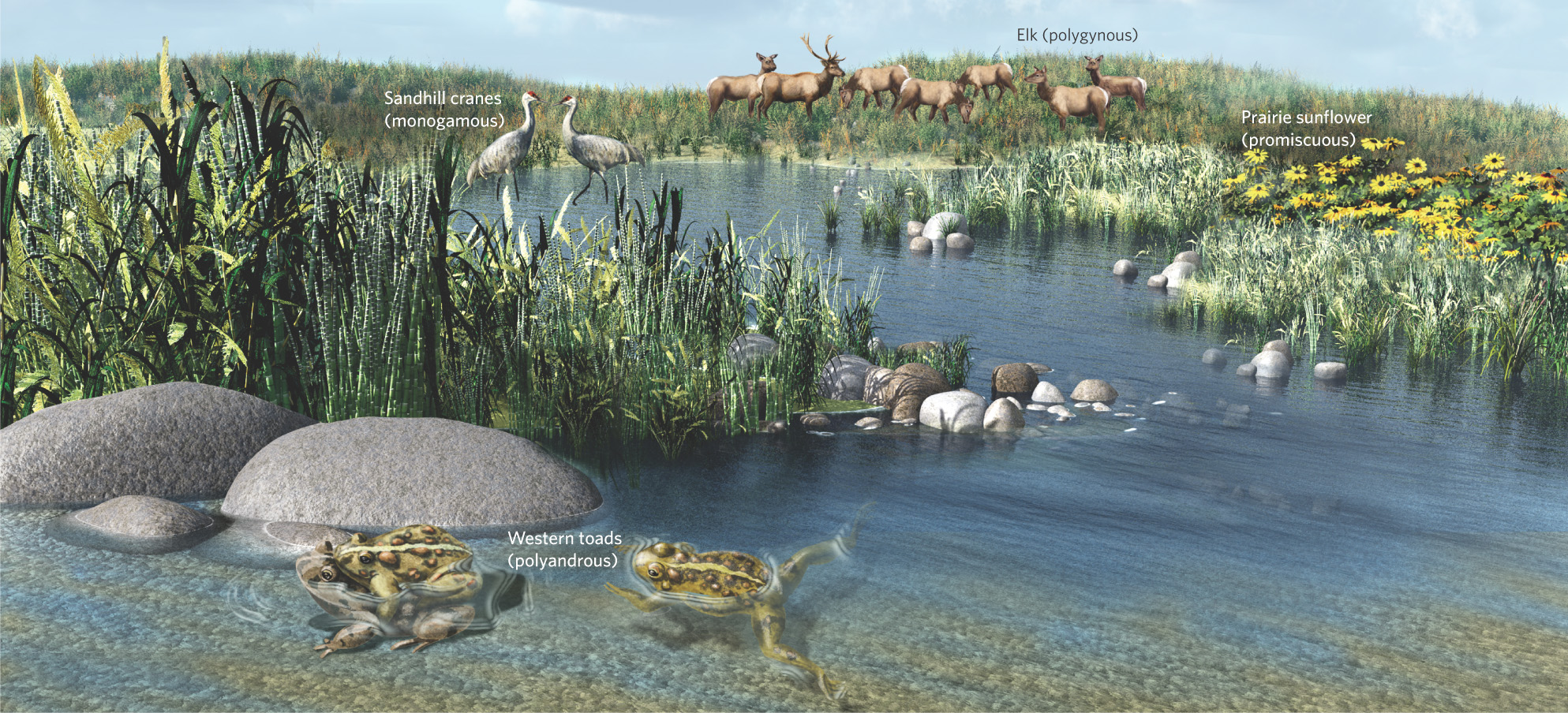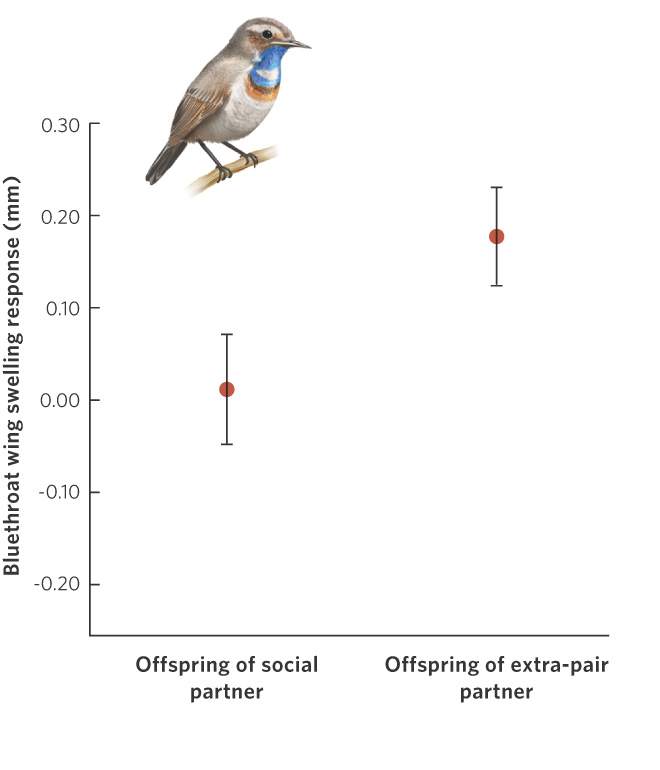Mating systems describe the pattern of mating between males and females
Although many species of algae and fungi have gametes that are of similar size, animals and plants produce sperm that are a fraction of the size of eggs. This smaller sperm takes much less energy to produce than an egg. Because of this difference, a female’s reproductive success depends both on the number of eggs she can make and on the quality of the mates that she finds. Because most males can produce millions of sperm, a male’s reproductive success generally depends on how many females he can fertilize. In this section, we will discuss the mating system of species, which describes the number of mates each individual has and the permanence of the relationship among mates. Like sex ratios, the mating system of a population is subject to natural selection. Consequently, mating systems are often a product of the ecological conditions under which species live. Figure 9.14 illustrates the four mating systems: promiscuity, polyandry, polygyny, and monogamy.

Mating system The number of mates each individual has and the permanence of the relationship with those mates.
221
Promiscuity
Promiscuity A mating system in which males mate with multiple females and females mate with multiple males and do not create a lasting social bond.
Promiscuity is a mating system in which individuals mate with multiple partners and do not create a lasting social bond. Among animal taxa as a whole, promiscuity is by far the most common mating system. Promiscuity is universal among outcrossing plants because they send pollen out to fertilize the eggs of multiple individuals and receive pollen from multiple individuals.
When animals release eggs and sperm directly into the water or when pollen is released into the wind, much of the variation in mating success is random. Whether a particular sperm is the first to find an egg is largely a matter of chance. When males attract or compete for mates, however, reproductive success can be influenced by factors such as body size and the quality of courtship displays. Even when fertilization is random, males that produce the most sperm or pollen and males that produce the most competitive sperm or pollen are bound to father the most offspring.
Polygamy
Polygamy A mating system in which a single individual of one sex forms long-term social bonds with more than one individual of the opposite sex.
Polygyny A mating system in which a male mates with more than one female.
Polygamy is a mating system in which a single individual of one sex forms long-term social bonds with more than one individual of the opposite sex. Most often, a male mates with more than one female, which is known as polygyny. In some species, polygyny evolves when males compete for females and the females all prefer only the few best males. In this case, the largest and healthiest males may mate with the vast majority of the females. Polygyny also can evolve when a male is able to defend a group of females from other males or when a male can defend a patchy resource that is attractive to multiple females. The guanaco, a relative of the camel that lives in the Patagonian region of South America, provides an example. The land in Patagonia is generally dry, with patches of wet habitat that grow nutritious plants that guanacos prefer to eat. When a male guanaco defends a wet patch from other males, he is able to mate with many of the females who come to the wet patch to eat the plants.
Polyandry A mating system in which a female mates with more than one male.
222
The opposite of polygyny is polyandry, a mating system in which a single female breeds with multiple males. The account of the queen honeybee at the beginning of this chapter is an example of polyandry because she mates with multiple drones. Polyandry commonly occurs when the female is in search of genetically superior sperm or has received material benefits from each male with whom she mates. For instance, in some species of insects, including some butterflies, the female receives a nutritional package of food— known as a spermatophore—from a male. The female uses the protein in the spermatophore to make her eggs. In polyandrous species, the more spermatophores that a female can collect, the more eggs she can produce.
Monogamy
Monogamy A mating system in which a social bond between one male and one female persists through the period that is required for them to rear their offspring.
Extra-pair copulations When an individual that has a social bond with a mate also breeds with other individuals.
Monogamy is a mating system in which a social bond between one male and one female persists through the period that is required for them to rear their offspring. In some cases, the bond may endure until one of the pair dies. Monogamy is favored when males make important contributions in raising the offspring, such as when a male bird’s help enables his chicks to grow and survive much better than they would without his help. Therefore his parenting improves his fitness. Having a social bond with only one other individual occurs in about 90 percent of bird species because males can offer much of the same care to offspring as females, such as incubating eggs, gathering food for the chicks, and protecting the chicks from predators. In mammals, however, fewer than 10 percent of species have a social bond with only one other individual. Because male mammals cannot provide the same offspring care as females, particularly because females lactate, the growth and survival of mammal offspring is less reliant on a male’s presence.
For decades, ecologists observed that many species of birds have a single partner with which they breed and raise offspring. This male represents their single social bond. With the development of new DNA technologies, scientists began to examine the genetic relationships between parents and offspring and discovered that offspring in a nest often have different fathers. This means that the mother copulated with other males. While these females had a social bond with only one male, they were actually breeding with other males, a behavior known as extra-pair copulation. In some monogamous species, a third or more of the clutches contain offspring sired by another male—usually a male in a neighboring territory. Since neighboring males also have a social bond with their own partner, both males and females use extra-pair copulations. Thanks to developing DNA technologies, we now know that 90 percent of bird species thought to be monogamous actually engage in extra-pair copulations.
Extra-pair copulations surely increase the fitness of the neighboring males, but how does this behavior increase the fitness of the female? One way would be if her reproductive success is improved by creating greater genetic variation among her offspring so at least one might be better suited to future environmental conditions. She could also benefit if the neighboring males have better genotypes than her mate. In a bird known as the bluethroat (Luscinia svecica), for example, extra-pair copulations are common. Researchers in Norway examined the immune response of chicks whose father was the social partner of the female versus the extra-pair partner of the female. To do this, the researchers inject a small amount of foreign material—which is extracted from kidney beans—into a bird’s wing and then they measure the amount of swelling that occurs at the site of the injection; the greater the swelling, the stronger the bird’s immune response. As you can see in Figure 9.15, the amount of swelling in the wing was greater in offspring produced by extra-pair copulations, which demonstrates that they had a stronger immune response. This suggests that females seek extra-pair copulations as a way to obtain superior genotypes from another male and produce offspring that have superior immune systems.

Mate guarding A behavior in which one partner prevents the other partner from participating in extra-pair copulations.
223
The male participating in a monogamous social bond does not benefit if his mate breeds with other males. The threat that she will participate in extra-pair copulations has selected for mate guarding, a behavior in which one partner prevents the other partner from participating in extra-pair copulations. A variety of mate guarding behaviors have evolved. In some species, an individual simply stays near its mate and keeps other potential suitors away, while in other cases the mate makes future breeding physically impossible. In 2004, for instance, researchers discovered that the golden orb-weaving spider (Argiope aurantia) inserts its sperm-transferring appendages into the two openings of the female’s reproductive system. Within a few minutes of transferring his sperm, the male’s heart stops and he dies with his appendages still stuck inside the female, making it impossible for the female to mate again. Such adaptations are effective at reducing the chance that an individual’s partner will breed with another mate.
The various mating systems are the product of natural selection and are shaped by the ecological conditions under which each species lives. Because the mating systems often involve attracting a mate or defending against other members of the same sex, natural selection has also caused the evolution of many sex-specific traits, as we will see in the next section.